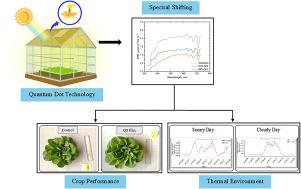Spectrally selective quantum dot laminated glass for photonic modulation and climate regulation in greenhouses
IF 7.9
3区 材料科学
Q1 GREEN & SUSTAINABLE SCIENCE & TECHNOLOGY
引用次数: 0
Abstract
The spectral and thermal environment in greenhouses is critical for optimizing crop performance, particularly during low-light winter periods. This study evaluated laminated glass integrated with CuInS2/ZnS quantum dots (QDs) that passively convert ultraviolet and blue photons into orange-red light (590–620 nm), enhancing the spectral quality of transmitted sunlight without requiring active energy input. Compared to a control glass, the QD-glazing increased relative red photon flux by 29% and increased the Red:Blue ratio by 57%, with negligible losses in total PAR (photosynthetically active radiation). Experimental trials conducted from January to February demonstrated that the QD-glazed greenhouse maintained a higher internal air temperature, averaging 0.68 °C warmer than the control. Root zone (nutrient solution) temperature also exhibited consistent thermal advantages, averaging 1–2 °C higher under the QD glazing, contributing to enhanced nutrient uptake. Vapor pressure deficit was elevated in the QD greenhouse during daylight hours, reflecting increased evaporative demand aligned with higher photosynthetic activity. Despite slightly lower DLI (Daily Light Integral) values, QD-treated lettuce exhibited a 37.8% increase in fresh biomass yield and a 41% improvement in light use efficiency, demonstrating that enhanced spectral quality and early-day thermal buffering can significantly boost physiological performance. Notably, concentrations of key macro-nutrients (N, P, K, Ca, Mg, S) and micro-nutrients (Zn, Cu) were significantly higher under QD treatment, indicating enhanced mineral uptake. These results underscore the potential of spectrally selective QD-glazing as a passive, energy-free solution for optimizing greenhouse microclimate and supporting resilient, winter-season crop production. The findings highlight a promising pathway toward climate-smart greenhouse envelopes that integrate photonics with sustainable food and energy strategies.

光谱选择性量子点夹层玻璃在温室中的光子调制和气候调节
温室内的光谱和热环境对优化作物性能至关重要,特别是在光照不足的冬季。本研究评估了集成了CuInS2/ZnS量子点(QDs)的夹层玻璃,该量子点被动地将紫外线和蓝色光子转换为橙红光(590-620 nm),在不需要主动能量输入的情况下提高了透射阳光的光谱质量。与对照玻璃相比,qd玻璃使相对红色光子通量增加了29%,红蓝比增加了57%,而总PAR(光合有效辐射)的损失可以忽略不计。1月至2月的试验表明,qd玻璃温室保持了较高的内部空气温度,平均比对照高0.68°C。根区(营养液)温度也表现出一致的热优势,在QD玻璃窗下平均高出1-2°C,有助于提高养分吸收。在白天,QD温室的蒸汽压亏缺升高,反映了蒸发需求的增加与更高的光合活性相一致。尽管DLI(每日光积分)值略低,但qd处理生菜的新鲜生物量产量提高了37.8%,光利用效率提高了41%,这表明增强的光谱质量和早期热缓冲可以显著提高生理性能。值得注意的是,在QD处理下,关键常量营养素(N、P、K、Ca、Mg、S)和微量营养素(Zn、Cu)的浓度显著升高,表明矿物质吸收增强。这些结果强调了光谱选择性量子点玻璃作为一种被动、无能源的解决方案的潜力,可以优化温室小气候,支持有弹性的冬季作物生产。这一发现强调了一条将光子学与可持续食品和能源战略相结合的气候智能温室外壳的有希望的途径。
本文章由计算机程序翻译,如有差异,请以英文原文为准。
求助全文
约1分钟内获得全文
求助全文
来源期刊

Materials Today Sustainability
Multiple-
CiteScore
5.80
自引率
6.40%
发文量
174
审稿时长
32 days
期刊介绍:
Materials Today Sustainability is a multi-disciplinary journal covering all aspects of sustainability through materials science.
With a rapidly increasing population with growing demands, materials science has emerged as a critical discipline toward protecting of the environment and ensuring the long term survival of future generations.
 求助内容:
求助内容: 应助结果提醒方式:
应助结果提醒方式:


